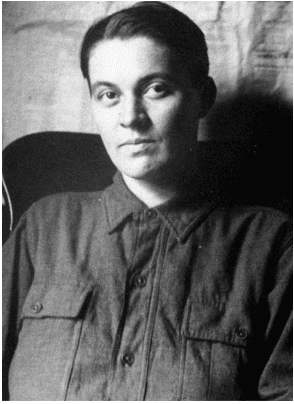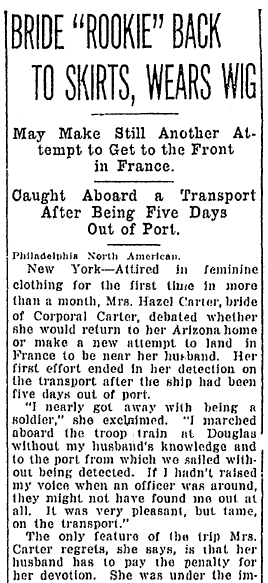Introduction: Gena Philibert-Ortega is a genealogist and author of the book “From the Family Kitchen.” In this blog article, Gena searches old newspapers to uncover the story of Hazel Carter, who disguised herself as a man in order to follow her husband into battle in WWI – and almost made it.
During the American Civil War, an untold number of women disguised themselves as men and fought on the front lines. These women risked their lives looking for adventure, higher wages, involvement in a cause they believed in, or to follow sweethearts or family members into battle. While it may be difficult to fathom how a woman could get away with passing herself as a man during the Civil War day in and day out, stories and books have been written about the women who did just that.
One might assume that as time marched on, women were less successful disguising themselves as men in order to go to war. After all, weren’t there medical examinations that would have uncovered this type of charade? Well, believe it or not – women tried to pose as male soldiers as recently as World War I!
Hazel Carter, WWI Soldier Girl
Hazel Blauser was born in 1894 and lived in Douglas, Arizona. On 12 December 1916 she married John Carter. John was serving with the 18th infantry, stationed in Douglas, when his unit was called up to go to France. Hazel decided that she would not be left behind. After saying her goodbyes to John, she headed off to a barber where she had her long hair shorn. Then, dressed in an old uniform, she went down to the military base where the soldiers were gathered and tried to get lost in the crowd of young men.

As she explained in this Nebraska newspaper article:
I marched aboard the troop train at Douglas without my husband’s knowledge and to the port from which we sailed without being detected.

Once on board the troop ship and out to sea, a rumor began circulating that there was a woman aboard. One account says it was because someone heard Hazel’s voice. She was discovered after being asked to remove her shirt. Hazel was then held in a stateroom and transported back to the United States without ever being allowed to step foot on French soil.
[search_box]
Once Hazel was back in the United States her story made newspaper pages across the nation. The adventure of the woman dressed as a WWI soldier was reported, including the fact that she was provided women’s clothes and a wig when she arrived in the United States prior to being sent home to Arizona. In some old newspaper articles she was even referred to as Private Hazel Carter (retired).
Writing Her Story in the Newspaper
Hazel was able to capitalize on her brief stint with fame by writing four articles about her adventure that were serialized in newspapers. Hazel detailed everything from her decision to follow her husband, to how she was able to hide on the troop train and her eventual boarding of the transport ship and how she “nearly got away with it.”
Her military adventure must have seemed like a grand story – except perhaps to her husband, who lost his rank of corporal and was threatened with court martial due to his wife’s attempt to be with him.
In her fourth installment of her article series, she reports that her mother had not known that Hazel had left Douglas until she was gone. Her mother wrote to Hazel:
If you wanted to be a soldier and fight with your man, it was all right with us. We’re proud of you. You’re an honor to the blood, and that has been fighting blood since before the Civil War.
Hazel’s mom wasn’t the only one that was proud of her. Her grandfather H. Clark, a veteran of the Civil War, was quoted as saying:
I knew she would do it…That girl sure has grit. I wish she could stay and fight the Germans. You ought to have seen her in uniform. She made a better looking soldier than John, I do believe. She can handle a rifle better than most men. They sure should have let her stay.
In addition to her family’s approval, Hazel had the admiration of her hometown, the city of Douglas, Arizona. A Michigan newspaper article announced that when she arrived home from her adventure, she would be “met by a guard of honor and a brass band.”
Hazel wasn’t the only woman to try to join the war effort dressed as a man during WWI. Another young woman, Freda Hart, also tried to disguise herself with the intent of joining the military but was “outed” before she could board a train for Washington, D.C. Hazel and Freda’s stories are recounted in this historical newspaper article with a title emphasizing their boyish haircuts, referring to their “sacrifice of tresses.”
While Hazel’s story makes it sound as though women weren’t involved in the war effort or on the battlefronts, nothing could be further from the truth. Did women help in the war effort? Absolutely! Women joined groups like the Red Cross as nurses, the Salvation Army and YWCA. Women even joined the military as nurses and clerical workers and were sent to France. Hazel remarked that she did try to join the Red Cross, only to be turned down.
A Story That Ends Too Soon
Does this love story between Hazel and John end “happily ever after”? Unfortunately, no. Hazel died about a year later, in July 1918 in New Mexico. Her husband, fighting the war in France, never saw her again after her discovery on his WWI troop ship. His last words to her can be found memorialized in one of the newspaper articles she wrote about her adventure:
Don’t let a little thing like that discourage you, honey. Go home and take a run down to Kentucky to see mother. Tell her I am well and doing all right. No Boche bullet is going to get me. Then if you still want to come over, join the Red Cross. I’ll work night and day to see you are sent somewhere near us. Be good, kiddie. Wait for me.
Hazel’s body was transported back to Douglas by the Red Cross, where she was provided with a military-like funeral that included a flag draped over her casket, a military chaplain officiating and soldiers as her pallbearers.
Hazel’s story is just one example of the rich family history you can find in old newspapers. What will you discover about your family in the pages of GenealogyBank’s Historical Newspaper Archives?
Related Articles:
- World War I Articles Recall Memories of Doughnuts & Lassies
- Earlier Women of War: Nurses, Camp Followers & Red Cross Volunteers
- WWI Christmas Truce: When the Guns Stopped Firing
- Rationing Thanksgiving Dinner during World War I
- Harrybelle (Durant) Stark: The Last Casualty of WWI
- 1918 Surrender of Germany Ends WWI & Veterans Rejoice
[bottom_post_ad]